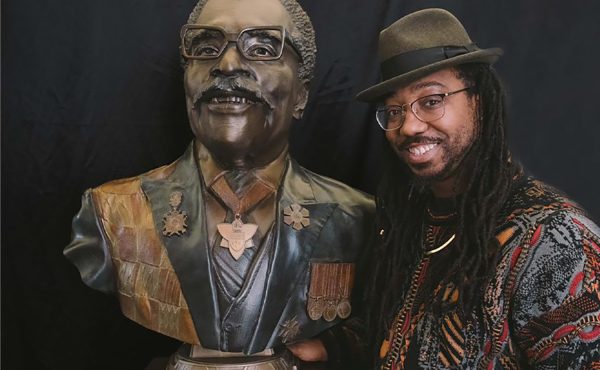
EDITOR: This is the first installment in our series following the ongoing Fort York archeological dig of the Government House site. Click here for more background on the dig.
![]()
Under a drizzle on Friday afternoon, a team of four archaeologists from ASI, with trowels in hand, were scraping back the layers of Fort York’s history. Layer by stratographic layer, these archaeologists are moving further back in time to the War of 1812. They are looking for the remains of the Government House, the official residence of the Lieutenant-Governor of Upper Canada, which was looted and destroyed by American troops as they left York in the spring of 1813.
This two-week long dig, sponsored by YAP Films and History Television, is part of a documentary to commemorate the bicentennial of the War of 1812. Given the short time frame, the area being excavated is modest, an area of 8m by 2m divided into four sub-operations. Although the house itself was much larger, the likelihood that they will come across foundation stones from either a segment of the outer wall or a cellar wall is rather high. When the Fort was rebuilt after the war the buildings were built around the ruins of the Government House and the remains of the building were covered and filled in to make the Fort’s present day Parade Ground leaving a relatively untouched area.
Plenty of additional calculations went into choosing the site, I was told by Eva MacDonald the excavation director, predominantly with the use of ground-penetrating radar (GPR). The radar identifies anomalies, beyond your average mix of brick, clay, and rocks that are found in the soil. Together with the GPR, existing maps of the fort, and an account from Captain Robert Pilkington who built the Government House, the team was able to determine this small section of lawn to be excavated. In fact, Pilkington’s plan of the Government House (see below) identifies two sets of stairs. “It is unclear whether the stairs are going up or down on the plan, but most likely they led to a cellar,” Eva explains. The only record of a cellar existing is in correspondence between Pilkington to Lt. General Hunter about the progress of building the house. In his letters Pilkington complained of heavy rain and poor drainage that delayed the excavation of the cellars and the laying of foundation stones.
When I visited the dig, which is well underway and half-way through, the team had already excavated 40cm below today’s ground level – through a layer of bricks and gravel laid out to help with drainage, thick dark soil, to the level of the parade grounds used in the 19th century. By 60cm, which they will reach within the next few days, they hope to reach the level of 1812, at which point they hope to find the remnants of the Government House. Each ‘cultural layer’ has revealed something about the Fort’s history: The upper layers showed a surprising mix of domestic and military wares from the early 20th and late 19th century. There were food bones found alongside the legs of an old china doll and a WWI military button.

In the brief hour I was there, Mary-Cate Garden, one of the two full-time archaeologists on the project, found a musket ball. It was the excitement of the day, a crowd gathered to see the lead bullet, feel its weight, comment on its make, but most importantly, comment on its age. Musket balls went out of use by the mid 19th century, but were the technology used during the Upper Canada Rebellion in 1837 and definitely during the War of 1812. Earlier in the week the team had found percussion caps from the bullets of the Brunswick rifle, technology that was introduced circa 1838 and was more accurate than muskets due to the rifled bore of the gun.
The musket ball was smooth and solid, heavier than I had expected. Having never been fired, it had most likely fallen out of a soldier’s pouch while marching across the parade grounds. Mary-Cate, while waiting for the film crew to come and record the moment, explained that the day before they had found a clay marble, with similar weight and size which had briefly fooled them. I enjoyed watching as the film crew rushed over, and Mary-Cate re-discovered the musket ball for the camera. What the musket ball did mean was that, under a layer of yellow clay, the team had finally hit the parade grounds of Fort York of the mid-19th century. One step further back in time.

Above photos courtesy of YAP Films. The archaeologists’ best guess at where their excavations will hit foundation walls are marked in red on Capt. Robert Pilkington’s plan of the LG’s House above; please note the stairs. (Credit: National Archives of Canada, C 16016)



2 comments
When I visited the Fort yesterday, I saw that there is a 2nd dig in progress, just outside the south wall of the fort. I was told this is in search of the famous “magazine” (i.e. ammunition storage building) that was blown up during the attack by American forces on April 27th, 1813. It was a devastating explosion that is said to have sent stones and beams flying up to 500 metres in all directions, causing the largest number of casualties that day including the American General, Zebulon Pike (of Pike’s Peak fame.) The explosion was heard for miles around, possibly one of the biggest explosions in North America up to that time.Anyway, I hope that dig will turn up some wonders as well and be featured in the upcoming doc by YAP Films
I visited Fort York last July and was awed to be walking where my gr gr gr gr grandfather, John Butts and his brother Moses served in the militia during the War of 1812. I was amazed that the Fort had almost been torn down and am thankful for everyone who keeps it alive.
Lyle